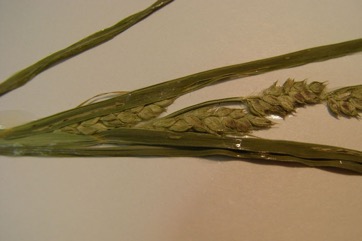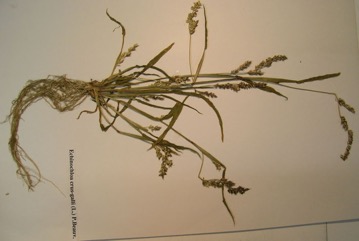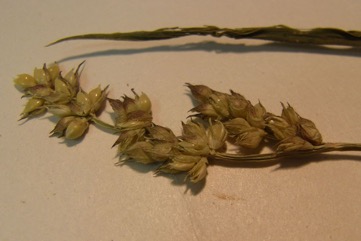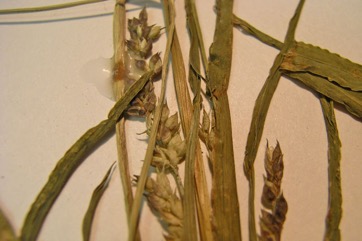Barnyard grass, Barnyard millet

A tropical plant. It grows in wet places and paddy fields. It grows in wetlands. It also grows in temperate places. Seed germinate most easily at 20°C. It grows in water-logged soils which are medium to heavy. It can grow in arid places. In Argentina it grows from sea level to 800 m above sea level. Tasmanian Herbarium. In Yunnan.
Also known as:
Adban samo, Ahibary, Bai, Banti, Barasanwak, Bharti, Bovar, Burashama, Capin arroz, Cockspur grass, Dhand, Dhera, Dul, God, Jalsamoka, Jarotha, Myet-cho, Myet-thi, Navadna kostreba, Oothupul, Osu honug, Pacad, Pedda wundu, Sama, Samak, Samaw, Sanwak, Sarvank, Sawan, Sema, Smau bak'kba, Tan, Ziro
Synonyms
- Echinochloa crus-galli var. breviseta (Doell.) Neilr.
- Echinochloa crus-galli var. longiseta (Doell.) Neilr.
- Echinochloa crus-galli var. mitis (Pursh) Peterm.
- Echinochloa crus-galli var. submutica Neilr.
- Echinochloa glabrescens Munro ex Eggel.
- Echinochloa hispidula (Retz.) Nees ex Royle
- Panicum crus-galli Linn.
- Panicum crus-galli var. brevisetum Doell.
- Panicum crus-galli var. longisetum Doell.
- Panicum grossum Salisb.
- Panicum hispidulum Retz.
Edible Portion
- Leaves, Seeds, Cereal, Vegetable
Where does Barnyard grass grow?
Found in: Africa, Argentina, Asia, Australia, Bahamas, Bolivia, Botswana, Brazil, Burkina Faso, Cambodia, Central America, Chile, China, Cuba, Czech Republic, East Africa, Eswatini, Europe, France, Greece, Haiti, Himalayas, India, Indochina, Indonesia, Iran, Iraq, Italy, Japan, Kiribati, Korea, Laos, Madagascar, Malaysia, Mediterranean, Mexico, Mongolia, Mozambique, Myanmar, Nepal, New Zealand, North America, Northeastern India, Pacific, Pakistan, Paraguay, Puerto Rico, SE Asia, Slovenia, Solomon Islands, South Africa, Southern Africa, South America, Spain, Sri Lanka, Swaziland, Taiwan, Tasmania, Uruguay, United States, West Africa, West Indies, Zimbabwe
Notes: There are about 35 Echinochloa species. They grow in tropical to warm temperate regions. It is a weed problem in rice. It is probably the wild form from which Japanese millet developed. It has anticancer properties.
Status: It is grown as a cereal in China, Korea and Japan. The seeds are a famine food.
Growing Barnyard grass, Barnyard millet
Cultivation: Plants are grown from seed.
Edible Uses: The young shoots are eaten as a vegetable. The seeds can be boiled and eaten. They can also be popped like corn. They can be ground into flour and used to make bread, cakes and porridge. They are used for macaroni and dumplings. They can be steamed and made in porridge. Roasted seeds are used as a coffee substitute.
Nutrition Info
per 100g edible portion| Edible Part | Energy (kcal) | Protein (g) | Iron (mg) | Vitamin A (ug) | Vitamin c (mg) | Zinc (mg) | % Water |
|---|---|---|---|---|---|---|---|
| Seeds | - | 11 | - | - | - | - |
Barnyard grass, Barnyard millet Photos




References
Ambasta, S.P. (Ed.), 2000, The Useful Plants of India. CSIR India. p 188
Bandyopadhyay, S. et al, 2009, Wild edible plants of Koch Bihar district, West Bengal. Natural Products Radiance 8(1) 64-72
Beckstrom-Sternberg, Stephen M., and James A. Duke. "The Foodplant Database." http://probe.nalusda.gov:8300/cgi-bin/browse/foodplantdb.(ACEDB version 4.0 - data version July 1994)
Blamey, M and Grey-Wilson, C., 2005, Wild flowers of the Mediterranean. A & C Black London. p 526
Burkill, I.H., 1966, A Dictionary of the Economic Products of the Malay Peninsula. Ministry of Agriculture and Cooperatives, Kuala Lumpur, Malaysia. Vol 1 (A-H) p 903
Cobley, L.S. (rev. Steele, W.M.) 2nd Ed., 1976, An Introduction to the Botany of Tropical Crops. Longmans. p 56
Dashorst, G.R.M., and Jessop, J.P., 1998, Plants of the Adelaide Plains & Hills. Botanic Gardens of Adelaide and State Herbarium. p 172
Duke, J.A., 1992, Handbook of Edible Weeds. CRC Press. p 90
Ess. Agrostogr. 53, 161, 169. 1812 "crus galli"
Facciola, S., 1998, Cornucopia 2: a Source Book of Edible Plants. Kampong Publications, p 175
Flora of Australia Volume 49, Oceanic Islands 1, Australian Government Publishing Service, Canberra. (1994) p 482
Flora of Pakistan. www.eFloras.org
Flora of Solomon Islands
GAMMIE, (As Panicum crus-galli)
Geng, Y., et al, 2016, Traditional knowledge and its transmission of wild edibles used by the Naxi in Baidi Village, northwest Yunnan province. Journal of Ethnobiology and Ethnomedicine. 12:10
Grubben, G. J. H. and Denton, O. A. (eds), 2004, Plant Resources of Tropical Africa 2. Vegetables. PROTA, Wageningen, Netherlands. p 561
GUPTA & KANODIA, (As Panicum crus-galli)
Hussey, B.M.J., Keighery, G.J., Cousens, R.D., Dodd, J., Lloyd, S.G., 1997, Western Weeds. A guide to the weeds of Western Australia. Plant Protection Society of Western Australia. p 52
Hu, Shiu-ying, 2005, Food Plants of China. The Chinese University Press. p 288
Hwang, H., et al, 2013, A Study on the Flora of 15 Islands in the Western Sea of Jeollanamdo Province, Korea. Journal of Asia-Pacific Biodiversity Vol. 6, No. 2 281-310
Hwang, HS, et al, 2014, Distribution characteristics of plant in the Ungseokbong Mountain, Gyeongsangnam-do, Korea. Journal of Asia-Pacific Biodiversity. 7(2014) e164-e178
Jardin, C., 1970, List of Foods Used In Africa, FAO Nutrition Information Document Series No 2.p 2
Khanal, R., et al, 2014, Documenting abundance and use of underutilized plant species in the mid hill region of Nepal. ECOPRINT 21: 63-71, 2014
Khasbagan, Hu-Yin Huai, and Sheng-Ji pei, 2000, Wild Plants in the Diet of Athorchin Mongol Herdsmen in Inner Mongolia. Economic Botany 54(4): 528-536 (Also as Echinochloa caudata and Echinochloa crus-galli var. mitis)
Kiple, K.F. & Ornelas, K.C., (eds), 2000, The Cambridge World History of Food. CUP p 117, 118
Kuhnlein, H. V., et al, 2009, Indigenous Peoples' food systems. FAO Rome p 148
Kuo, W. H. J., (Ed.) Taiwan's Ethnobotanical Database (1900-2000), http://tk.agron.ntu.edu.tw/ethnobot/DB1.htm
Lamp, C & Collet F., 1989, Field Guide to Weeds in Australia. Inkata Press. p 108
Lamp, C.A., Forbes, S.J. and Cade, J.W., 1990, Grasses of Temperate Australia. Inkata Press. p 144
Lazarides, M. & Hince, B., 1993, Handbook of Economic Plants of Australia, CSIRO. p 86
Long, C., 2005, Swaziland's Flora - siSwati names and Uses http://www.sntc.org.sz/flora/
Macmillan, H.F. (Revised Barlow, H.S., et al), 1991, Tropical Planting and Gardening. Sixth edition. Malayan Nature Society. Kuala Lumpur. p 351
Mal, B., S., et al, (Eds), 2010, Minor Millets in South Asia. Bioversity.
Malezas Comestibles del Cono Sur, INTA, 2009, Buernos Aires
Manandhar, N.P., 2002, Plants and People of Nepal. Timber Press. Portland, Oregon. p 211
Martin, F.W. & Ruberte, R.M., 1979, Edible Leaves of the Tropics. Antillian College Press, Mayaguez, Puerto Rico. p 194
Martin, F.W. & Ruberte, R.M., 1979, Edible Leaves of the Tropics. Antillian College Press, Mayaguez, Puerto Rico. p 194 (As Panicum crus-galli)
Mishra, N., et al, 2016, Indigenous knowledge in utilization of wetland plants in Bhadrak district, Odisha, India. Indian Journal of Natural Products and Resources. Vol. 7(1) pp. 82-89
Ochse, J.J. et al, 1931, Vegetables of the Dutch East Indies. Asher reprint. p 335
Paczkowska, G. & Chapman, A.R., 2000, The Western Australian Flora. A Descriptive Catalogue. Western Australian Herbarium. p 102
Peters, C. R., O'Brien, E. M., and Drummond, R.B., 1992, Edible Wild plants of Sub-saharan Africa. Kew. p 21
Phon, P., 2000, Plants used in Cambodia. © Pauline Dy Phon, Phnom Penh, Cambodia. p 267
Plants for a Future database, The Field, Penpol, Lostwithiel, Cornwall, PL22 0NG, UK. http://www.scs.leeds.ac.uk/pfaf/
Plants of Haiti Smithsonian Institute http://botany.si.edu/antilles/West Indies
Purseglove, J.W., 1972, Tropical Crops. Monocotyledons. Longmans p 144
READ, (As Panicum crus-galli)
Romanowski, N., 2007, Edible Water Gardens. Hyland House. p 94
Royal Botanic Gardens, Kew (1999). Survey of Economic Plants for Arid and Semi-Arid Lands (SEPASAL) database. Published on the Internet; http://www.rbgkew.org.uk/ceb/sepasal/internet [Accessed 8th May 2011]
SAXENA, (As Panicum crus-galli)
Sainty, G.R. & Jacobs, S.W.L., 1981, Waterplants of New South Wales. Water Resources Commission. NSW p 174
Scudder, 1962,
Singh, H.B., Arora R.K.,1978, Wild edible Plants of India. Indian Council of Agricultural Research, New Delhi. p 84
Singh, V. and Singh, P., 1981, Edible Wild Plants of Eastern Rajasthan. J. Econ. Tax. Bot. Vol 2 pp 197-207
Simkova, K. et al, 2014, Ethnobotanical review of wild edible plants used in the Czech Republic. Journal of Applied Botany and Food Quality 88, 49-67
Stephens, K.M., & Dowling, R.M., 2002, Wetland Plants of Queensland. A field guide. CSIRO p 67
Swaziland's Flora Database http://www.sntc.org.sz/flora
Tasmanian Herbarium Vascular Plants list p 84
van Wyk, B., 2005, Food Plants of the World. An illustrated guide. Timber press. p 183
World Checklist of Useful Plant Species 2020. Royal Botanic Gardens, Kew
Zhang, Y., et al, 2014, Diversity of wetland plants used traditionally in China: a literature review. Journal of Ethnobiology and Ethnomedicine. 10:72